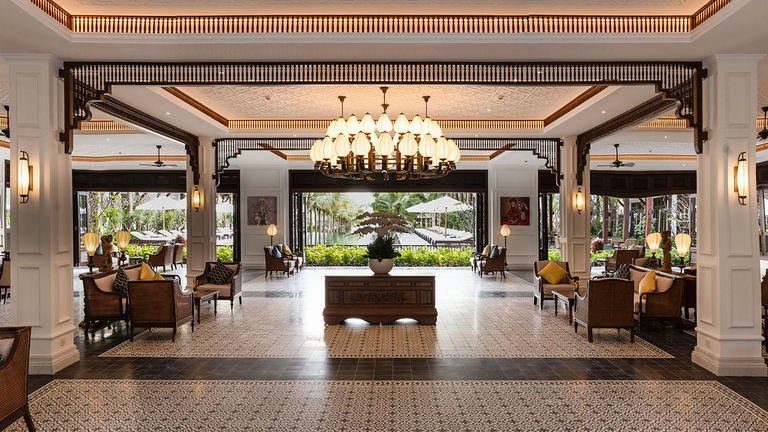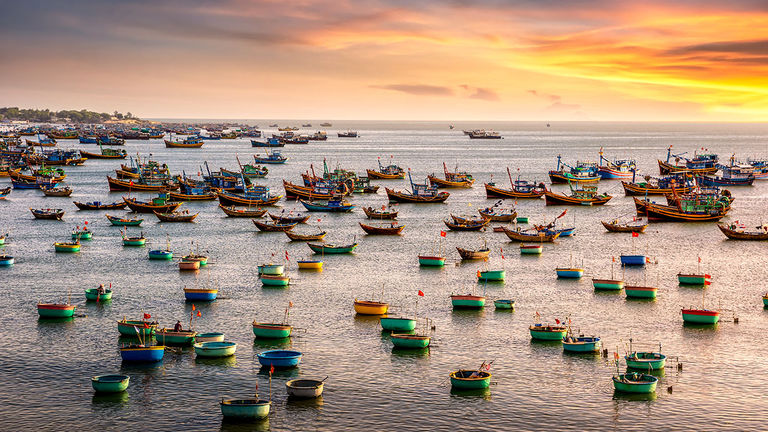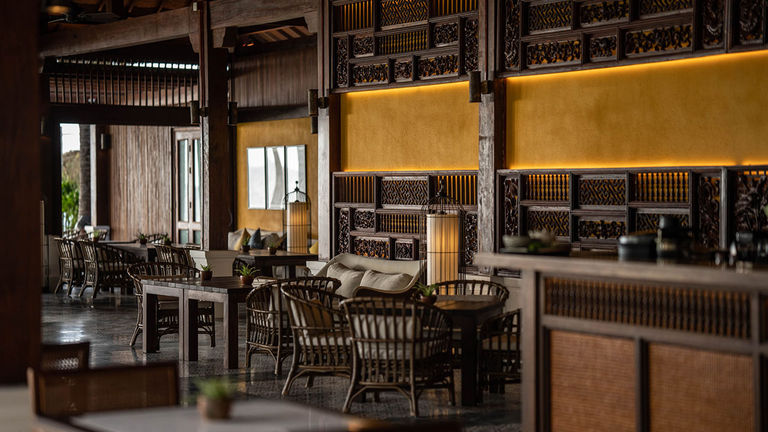Over a cup of rich and creamy Vietnamese coffee, banh chung (sticky glutenous rice cakes) and a piping-hot bowl of pho, I peeked over my breakfast table at The Anam Mui Ne and over to the resort’s infinity freshwater pool, which cascaded down toward the East Sea.
It couldn’t have been much later than 7 a.m., but a hotel guest in flowing resort wear was already ankle-deep in the shallow end of the pool, maneuvering her body into tree pose for a photo, her partner snapping shots from various angles as the sunrise illuminated her silhouette.
An employee of The Indochine, the resort’s al fresco restaurant, stepped onto the terrace to refill my coffee. “Beautiful, isn’t it?” she asked, gesturing to the view. “Every morning, guests wake up early to take photos here.”
 The Indochine restaurant has an alfresco terrace.
The Indochine restaurant has an alfresco terrace.
Credit: 2025 The Aman Mui Ne Resort
I could certainly see why — in fact, I was discovering photo ops around every corner of the 127-room resort, which opened in early 2023 as Vietnam’s sole member of Small Luxury Hotels of the World.
The Anam Mui Ne is the second property from The Anam Group, which also operates its flagship property, The Anam Cam Ranh, about three hours north. That property, which opened in 2017 and is about 10-times the size of its Mui Ne counterpart, has been met with great acclaim: Recently, it landed a coveted spot on Fodor’s Finest Hotels list for 2025 as one of the 100 best hotels in the world, thanks to its “imperial-style aesthetics and idyllic ocean views.”
And in many ways, The Anam Mui Ne is set up for a similarly bright future, with its Indochine-era design, prime stretch of shoreline, delectable cuisine and thoughtful accommodations.
 The resort’s lobby features antique tiles and teak wood touches.
The resort’s lobby features antique tiles and teak wood touches.
Credit: 2025 The Aman Mui Ne ResortA Nod to A Bygone Era
The name “Anam” itself is an ode to a specific period in Vietnam’s history, when the central part of the country was referred to as “An Nam.” Influence from the French Indochine period (1883-1940) is still sprinkled throughout many of Vietnam’s major cities, most apparent in architecture (Think: the French Colonial style of Hanoi’s Opera House, or Saigon’s Central Post Office) and cuisine (the bahn mi, a staple in Vietnam, often includes a pate spread on a crunchy baguette).
But head to smaller beach towns in the central part of the country, such as Mui Ne, and visitors may notice more traditional elements of Vietnamese culture at the forefront of their experience, including an abundance of thung chai (round basket-style fishing boats) dotting the shoreline, local markets selling traditional handicrafts and centuries-old Cham-era temples.
 Mui Ne is known for its round fishing boats, which guests can go see during a cultural excursion.
Mui Ne is known for its round fishing boats, which guests can go see during a cultural excursion.
Credit: 2025 The Anam Mui NeAt The Anam Mui Ne, the resort beautifully blends the more traditional culture of its host destination with luxurious and romantic Indochine-era design. While here, hotel guests can book excursions to the area’s fishing village, sand dunes, nearby temples and more, or can opt to explore the property. Although the hotel itself is compact, there are plenty of options: In addition to the two on-site pools (one freshwater, one salt water), guests have access to the beach, along with a small fitness center and two spas (The Anam Spa, which features a variety of body treatments with the option to use the resort’s homemade coconut oil; and the new beachside spa, where I enjoyed a facial accompanied by a symphony of lapping waves.) The beauty of the hotel’s grounds continues once inside, where the hotel’s interior design is also a visual feast for the senses. Antique tiling fills the grand lobby (and is also found in most of the guestrooms and suites), along with teak wood accents from Vietnam’s Thanh Hoa province.
I was always happy to greet my 592-square-foot Grand Premium Room each evening, which was on the second level of one of the hotel’s standalone villas (Private Pool Suites are on the bottom level) and included design touches such as a clawfoot bathtub, a colorful tiled floor paired with a neutral color palate, dark teak wood, artwork by local artisans and a balcony with, you guessed it, stunning views.
 The writer stayed in a spacious Grand Premium Room, which featured a balcony.
The writer stayed in a spacious Grand Premium Room, which featured a balcony.
Credit: 2025 The Aman Mui Ne ResortA Fusion of Flavors
Food is taken seriously at Anam Mui Ne, a point of pride for Peter Ye, resort manager and former executive chef and advisor to The Anam Group. Ye's collaboration with the resort’s culinary team is perhaps most prominent at the on-site Lang Viet Restaurant & Bar, the property’s Vietnamese outpost, where the menu is divided by the country’s three regions (North, Central and South). Following Ye's recommendation, I tasted my way across the country during my three-day stay, starting with Bun Cha (grilled pork belly and meatballs, vermicelli noodles, fish sauce and plenty of local herbs) from the North; white sardine salad and Mi Quang Noodles (flat rice noodles with braised pork ribs, poached prawns, quail eggs, peanuts, and shallots) from Vietnam’s Central Quang Nam province; and fresh lotus root salad (from the South).
 Lang Viet serves up Vietnamese staples from every region of the country.
Lang Viet serves up Vietnamese staples from every region of the country.
Credit: 2025 The Aman Mui Ne ResortAcross the courtyard from Lang Viet lies Saigon Bar, a cozy hideaway featuring handcrafted cocktails next to the resort’s beachside saltwater pool, a perfect spot for a nightcap and just steps from the resort’s golden stretch of beach. And then there’s The Indochine, which offered an impressive spread of European and Vietnamese favorites for breakfast, along with a lunch menu paying homage to French-Vietnamese fusion (My personal favorite? The hand rolls featuring ripe mango, dragon fruit, noodles, peanuts, mint and a Hoisin dipping sauce).
In fact, the dragon fruit is also a staple in Mui Ne, thriving in the area’s warm environment (with 300 days of sunshine, Mui Ne has the driest climate in all of Vietnam, Ye pointed out). After a long day of touring the area, I ordered a dragon fruit smoothie from the Lobby Bar to cool down. Taking my smoothie to go, I ventured to the saltwater pool, pausing to admire the surroundings once again, and lamenting the fact that I didn’t have my camera with me — for the second time that day.
But it didn’t really matter. I knew I would carry the memory of The Anam Mui Ne long after I returned home. It was all too picture-perfect.
Getting to Mui Ne
Clients can get to Mui Ne from Ho Chi Minh City in two hours, thanks to a recently constructed highway, with a complimentary daily shuttle operating daily for resort guests. Visitors flying into Hanoi (or Ho Chi Minh City) can also opt to take a train, which will arrive near Phan Thiet. An international airport is also set to open in Mui Ne this year.